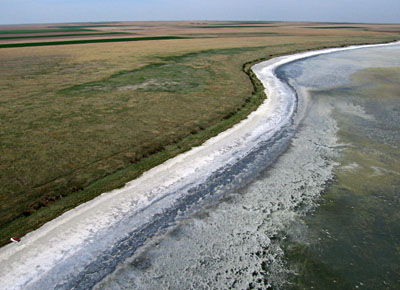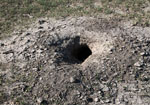
|
Scott County, Kansas
J.S. and S.W. Aber |

|
Scott County, Kansas
J.S. and S.W. Aber |

| Satellite image of Dry Lake vicinity, on the High Plains of west-central Kansas. Active crops (mostly winter wheat) appear bright green, and fallow fields are pink and maroon colors. The checkerboard pattern reflects alternate-year cropping. This image dataset was acquired on May 16, 2007, just two days before our initial observations at Dry Lake. Landsat false-color image based on visible, near-infrared, and mid-infrared bands. Dataset obtained from USGS Glovis; image processing by JSA. |
| 2007 | 2008 | 2009 | 2010 | 2011 |
| 2012 | 2013 | 2014 | 2015 |
![]()

| Overviews looking toward the northeast (left) and northwest (right). This is the first time the lake has held water since 2010. Repeated heavy summer rains replenished soil moisture, filled small puddles and ponds, and generated sufficient runoff to refill the lake basin partially. |  |

| Left: view to north with kite flyers at lower center in a prairie dog town. Right: water body in center of lake displays a distinctive yellowish-green color, presumably caused by algae and drowned weedy vegetation. |  |

| Left: our normal access road (lower left) was blocked by mud in a small playa depression (scene center); we had to deviate across the fallow field. Right: extensive prairie dog town is evident in the fallow field; kite flyers in upper left corner. |  |

| Ground views. Left: extensive mud flat marks the southern margin of the lake, and saltcedar (Tamarix ramosissima) bushes occupy the terrace along the edge of the basin. Right: cattle grazing in a water-filled playa near Dry Lake, a rare sight on the High Plains. |  |

| Overviews looking from the western end toward the northeast. The lake is completely full following repeated spring rains. Water has not been this abundant since the high stand of 2007, when our annual observations began. |  |

| Views toward the north (left) and northwest (right). The milky water color reflects suspended sediment stirred up from the shallow lake floor by wind-driven waves. |  |

| Left: authors conducting KAP next to the prairie-dog town on the southern side of the lake. Right: Swainson's hawk (Buteo swainsoni), which flew all the way from Argentina to breed here. It was cruising for prey over the prairie-dog town and along the lake shore. |  |

| Left: small playa depression on the upland south of Dry Lake. Our normal access road was under water, and we had to deviate around the playa. Right: wheat harvest was fully underway during our visit. | 
|
![]()
Thanks to local landowners for permission to conduct aerial photography.



 |
![]() Return to KAP home or gallery.
Return to KAP home or gallery.
All text and imagery © by the authors.
Last update July 2015.